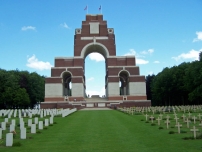| First Name: | Robert | Last Name: | JAMES | |
|---|---|---|---|---|
| Date of Death: | 01/11/1916 | Lived/Born In: | Whitechapel | |
| Rank: | Private | Unit: | Dorset6 | |
| Memorial Site: | Thiepval Memorial, France | |||
Current Information:Born-Whitechapel
The Battle of the Somme (July-November, 1916) By the beginning of November, 1916, the Battle of the Somme had been raging for four months. Thousands of men had already been killed or wounded or were simply missing, never to be seen again and just a few square miles of the French countryside, nearly all in the southern part of the battlefield, had been captured from the enemy. With November came the winter weather and this, combined with the sheer exhaustion of all involved, brought the battle to a close by the end of the month. Since the 1st July, 1916, British, Canadian, Australian, New Zealand and South African casualties numbered over 400,000, killed, wounded and missing. During November the focus of the fighting switched to the Ancre valley where the last major British offensive was launched on 13th of the month. By now German defence tactics had evolved. They defended in depth without a well defined front line but rather setting up machine-gun nests in shell holes and other strategically important sites where just a few men could hold up an entire battalion. Meanwhile their artillery bombarded the British front line and all the communication trenches added to which the weather was simply awful turning the battlefield into a morass of mud. A few gains were made such as the capture of the village of Beaumont-Hamel and some of the marshy land either side of the river, but very few of the British objectives were achieved. Once again the casualty rate soared. Robert James was killed in action on 1st November, 1916 while serving with the 1st Dorset battalion of 14 Brigade, 32nd Division on the Somme, but as yet there is no further information concerning his death. The attrition rate among British soldiers on the Western Front was on average 300 each day and 60% of these were as a result of shellfire. When not involved in an actual battle it was either shell fire or a sniper’s bullet that caused most deaths and injuries. |
||||
| « Back to Search Results | ||||
| If you think any of the information shown here is incorrect, Click Here to submit your amends and comments | ||||




